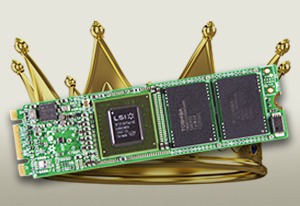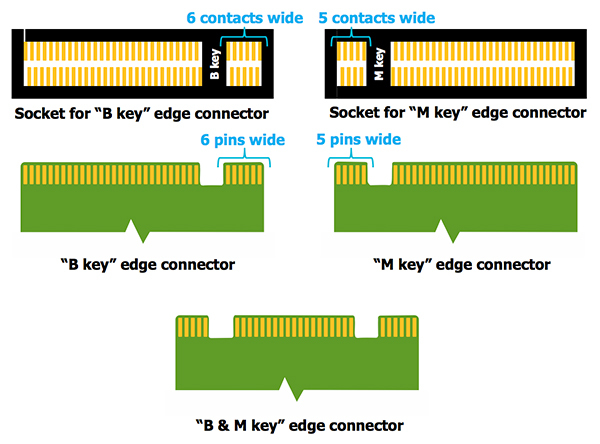Is M.2 the prince of SSD form factors?
- Transfer

In my translation of the article about SSD form factors, I talked about how various SSD solutions evolved. In short, the M.2 format was also affected, which in fact deserves a closer look. Recently, the second part of the article, shedding light on this issue, was published on the LSI blog. I bring to your attention its translation.
History
Several years ago, the non-profit organization PCI Special Interest Group (PCI-SIG), in partnership with The Serial ATA International Organization (SATA-IO), began developing a standard that combines the ideas of Mini-PCIe and mSATA, these two standards were designed to replace the innovative M. 2. The new board and connector were to be used for many peripherals, WiFi, WWAN, PCIe, GPS, NFC and SATA with SSDs that support both PCIe and SATA interfaces. The groups set out to create a narrower connector offering higher speeds, thinner cards and variable length expansion cards to support very small computers and laptops.
The new format also had to support micro-servers and similar high-density systems, allowing you to install dozens of M.2 cards. Unique cuts on the connector, also called “keys,” should help distinguish between a wide range of products using the M.2 connector and protect against incompatible devices in unsuitable connectors.
Renaming
Initially, the M.2 form factor was to be called the “Next Generation Form Factor” or NGFF for short. At this time, PCI SIG was already developing a specification that wore such an abbreviation, therefore, to avoid confusion, the new development was renamed to M.2. The name didn’t take root quickly, so in many articles these decisions are called “M.2, formerly known as NGFF”.
The keys
In the world of connectors and sockets, “keys” help to avoid connecting incompatible equipment, as well as protect against incorrect connections (for example, the wrong side). The M.2 specification defines 11 key configurations, 7 of which are reserved for future use. Sockets should always have one key protrusion, while expansion cards can have many key cuts if they are compatible with several different sockets at the same time. Of the 4 keys currently in use, 2 are used for SSDs. The key with identifier B (pins 12-19) gives the PCIe SSD up to two data lines, and the key with identifier M (pins 59-66) gives four lines. Both options can also support SATA devices. All options for placing keys are unique, so connecting the card upside down will not work.

Unfortunately, the keys alone are not enough to tell the user enough about the SSD and help to choose the right device for upgrade / replacement. For example, a computer with an M.2 socket for PCIe x2 uses key B, which does not allow you to connect a card with PCIe x4 (key M). But at the same time, a SATA M.2 card with key B can be safely connected, despite the fact that the computer does not recognize SATA commands coming through the PCIe M.2 socket. Due to this incompatibility of signals, users need to carefully study additional data that is either printed on the socket or indicated in the instructions to understand whether the socket is a SATA or PCIe.
Length and height
The pins of the M.2 connector are more dense than previous standards. This allows you to make the board already, and, therefore, opens the way for thinner and lighter mobile computers. Moreover, the M.2 specification describes modules with components located only on one side of the board, leaving enough space for other components between the motherboard and the expansion card itself. The number of flash chips used by SSDs varies depending on the size of the drive, so shorter boards can be made for smaller drives, leaving enough space for other components of the mobile system.

What's in your name
When I hear people call this specification “M.2, formerly known as NGFF,” I involuntarily recall the story of musician Prince, who changed his own pseudonym to an unpronounceable symbol, and everyone was forced to call him “an artist formerly known as Prince ". In that case, I think it was done for the sake of extra PR hype.
In the case of renaming NGFF to M.2, I doubt that the goal was the same. In fact, I'm sure the main idea behind the renaming was to simplify branding by removing the middle name for the same specification. Although it does not matter what we call this new form factor, it is rightly designed for prosperity in both mobile computers and the high-density server market.
